Last week we talked about controlling possession and the tools that could help you teach your team in that manner, and now we are back with a piece about pressing and counter-pressing. Those two almost exclusively go side by side in modern football and are used as some of the main tools of domination in today’s game. The world’s best teams like Jürgen Klopp’s Liverpool, Julian Nagelsmann’s RB Leipzig, and Marco Rose’s Borussia Mönchengladbach all employ these into their tactics and rely on them as their main weapon in most of the duels they play.
The system of coaching those segments of the game requires a lot of work on a physical plan because it needs to be practised in high-intense sessions, but also huge attention to communication between the players and structural organisation when out of possession. This coaching tactical analysis will show you the three drills that could be of great help for you if you want your team to play counter-pressing high-intense football, along with developing plenty of different other skills.
Overview
Pressing game is based on aggression and tackling directed to the player with the ball in order to prevent him from having solutions and shortening the amount of time he has to make a decision. Most of the pressing sides are focused on creating pressing traps, but in this analysis, we’ll try to set our focus on the reactional-pressing, which happens when the ball is in the transition from one side to the other, and whenever the team loses the ball.
The thing we’d like to point out in the counter-pressing game is that it is fully dependent on the compactness of your team when defending, so the balance and understanding between your players need to be on a very high level. That’s why all of the exercises we are going to show you have a lot of other usages besides the coaching of pressing.
Diego Simeone’s rondo (with adjustments)
The first drill we are going to talk about is the one that world-class Argentinean coach Diego Simeone uses at Atlético Madrid. The setup of the session is very simple – two squares, one inside the other, with smaller one the size of 7-10×7-10 meters, whilst the bigger one is around it in a three-meter distance from every line. The usual rondo takes place in the inside box, as the players are lined up to play a 5v2 game (this can vary depending on the number of players you want to use).
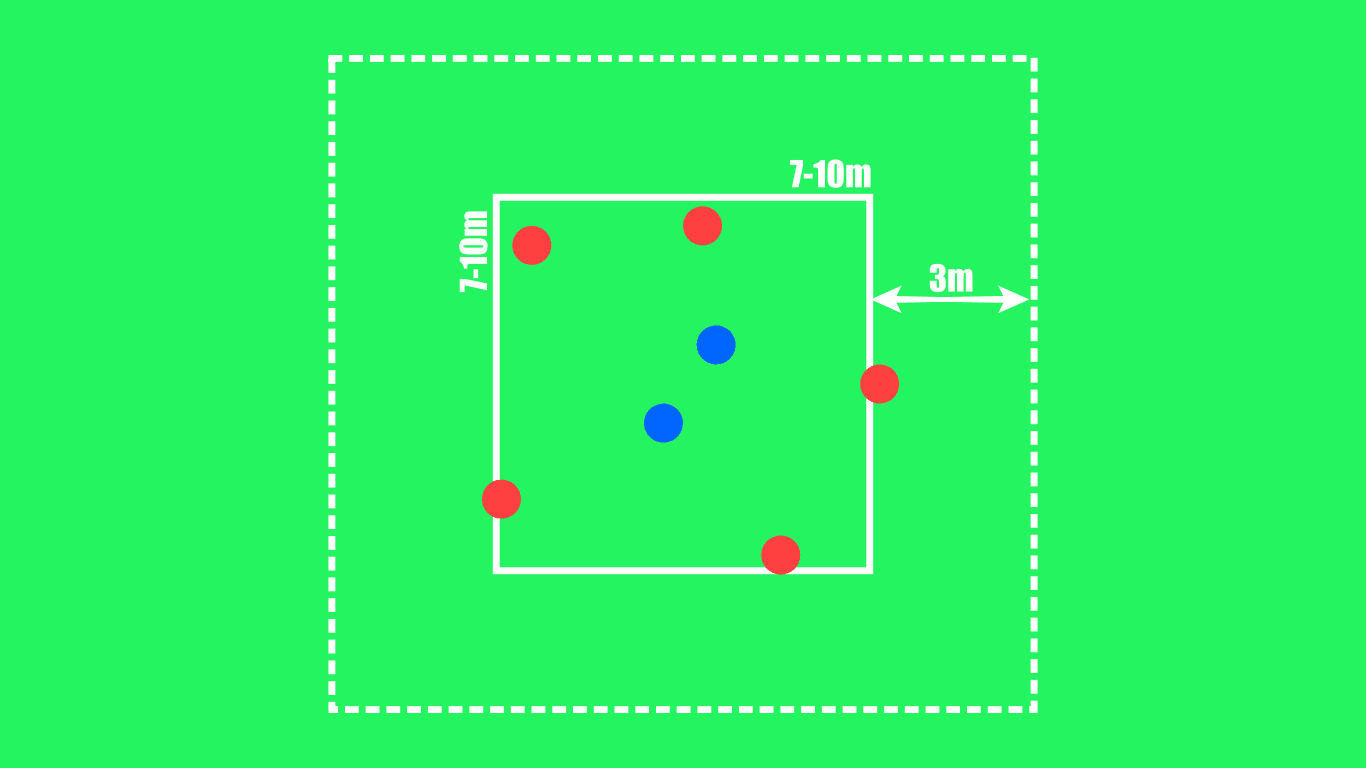
Here you can see the initial setting of the drill like it was described in the previous paragraph. The only modification this, on the first glance very easy, exercise has is related to the existence of the outside lines.
In order to set minds straight for pressing and prepare themselves for the high-intensity which pressing training requires, players, go for the return-runs towards the outside-box line and back into the inside box whenever they pass the ball. That means that after the player passes, he’s not an option anymore due to the obligation to run outside of the rondo, and every player basically always has just three options.
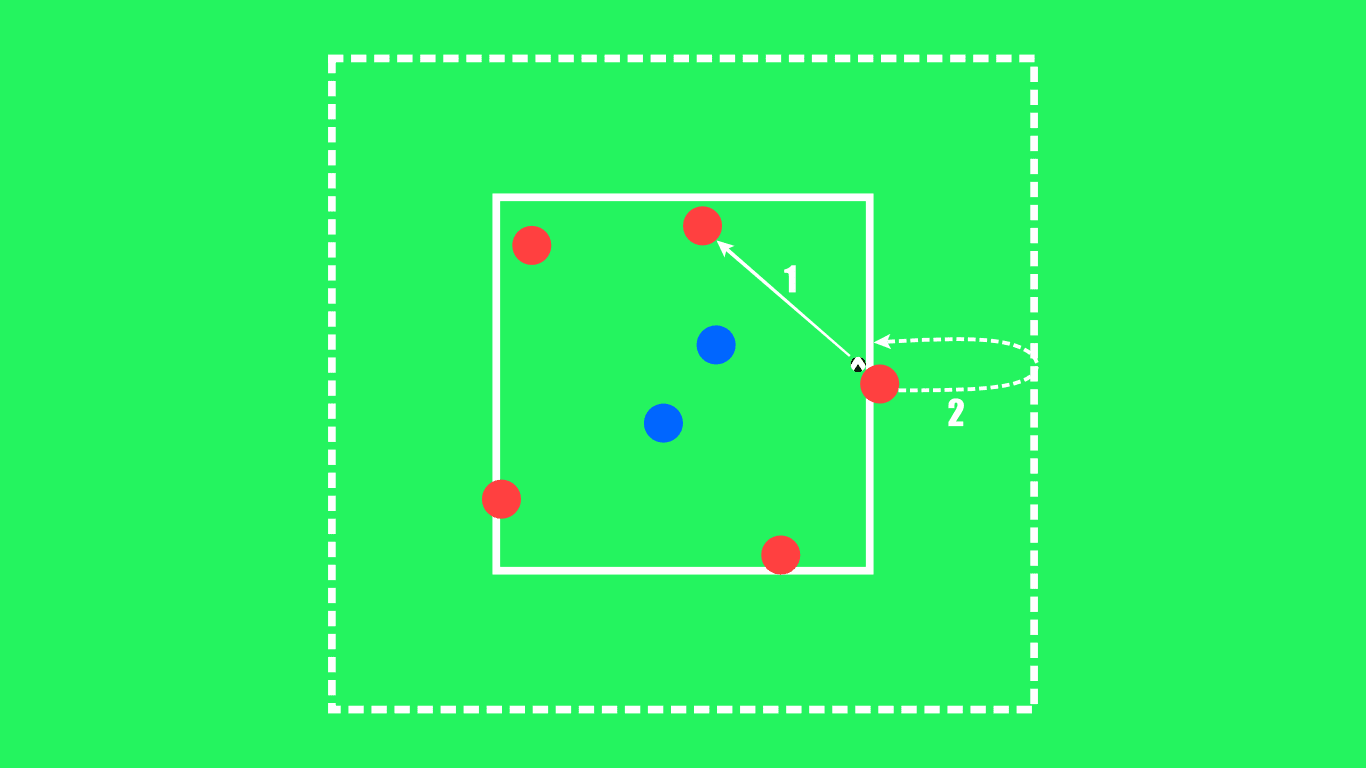
The idea of this drill is to set minds of the players into pressing state, thinking about the passing game through the worst-case scenario and considering every pass as a possible mistake. If observing in that way, every player goes for a quick close rush, building on aggression and stability that are crucial for counter-pressing.
Also, in the better case scenario, this game panders your player to move after they passed the ball, making them used to constant motions, which can help your possessional game. They need to do the return-runs quickly either way, as they need to make themselves an option once again in an as short time as possible. Whenever the players count to 21 passes, the defenders get the additional time to chase the ball. When the ball is lost, one of the inside players is replaced with the player that made the mistake.
Initial setup can have its modifications in terms of number of touches players in rondo have, number of players keeping the ball/defending or distance the attackers need to travel after they passed the ball. It is recommended that coaches encourage a slow start, but build intensity through this drill, which is most commonly employed in the opening phase of practise.
Diego Simeone’s ‘return-run’ rondo has its variations with the goal of making it more of a counter-pressing drill., which require adjustments in terms of setup. The change that is happening to the field is the four small goals at every corner of the outside box, which are no wider then 1-1,5 meter.
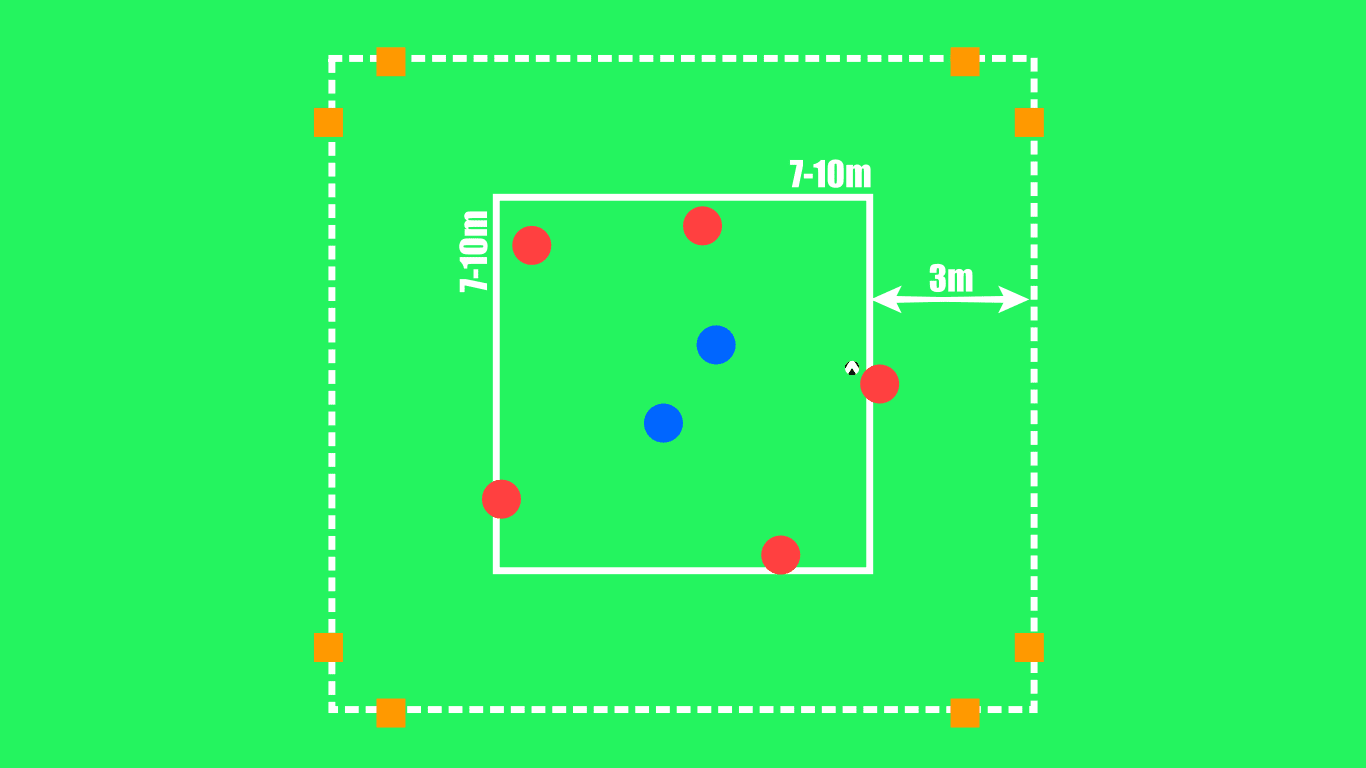
The orange cones are the gates that are added to the field and they are the ultimate goals for defenders in this modification of the drill. Once again, the rondo inside the box happens in its usual manner, but with no Red players exiting towards the outside box when they pass the ball. The main adjustment is that Blues have the task to pass through whichever of the four goals outside the rondo after they win the ball.
When possession is lost, Reds need to counter-pressure Blues and prevent them from succeeding in their task by coming inside and defending aggressively. Blues need to try to pass the ball through the gates in the shortest possible period, finding the gap in the defence and penetrating through the counter-pressing.
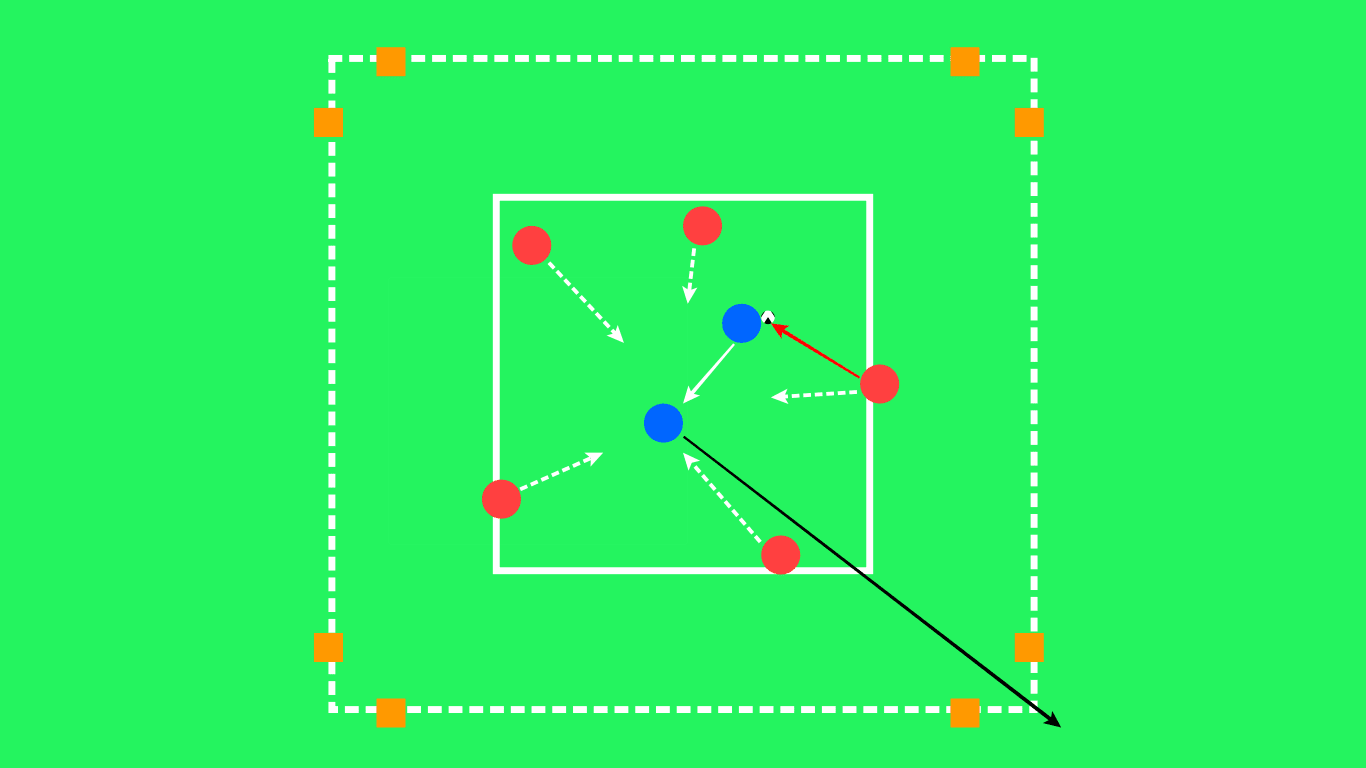
Red players need to react quickly after they’ve lost the ball and need to close down the passing lanes towards the corner goals. This time, there is no switching in roles and it is recommended to go with pairs of players in defensive roles for eg. two midfielders/centre-backs/strikers in order to develop their communication. This is the competitive game and the Blue team is awarded two points whenever they succeed in passing through the gate, and the Reds get one point when they count to 21.
The modification to the initial drill focuses on the counter-pressing and forces your player to react quickly after they lose the ball, but also to be conscious of their positioning in order to keep the defensive structure and protect passing lanes through it. As you can notice, it develops a lot more than just pressing game, since it is closely related to passing and communication build-up.
Three-colour transition
Next exercise is way different than the first one, and the same amount difficult than it. It requires a bigger field, divided into three zones – two 12×12 meter boxes with the 3×12 meter zone between them. The game is played by three teams of five players, with two teams having their full manpower in the wide boxes while the third party is the one defending. They have three of two of their players positioned in the box in which the game cracks up, and the other three are settled in the neutral zone waiting to intercept the passes that switch the play.
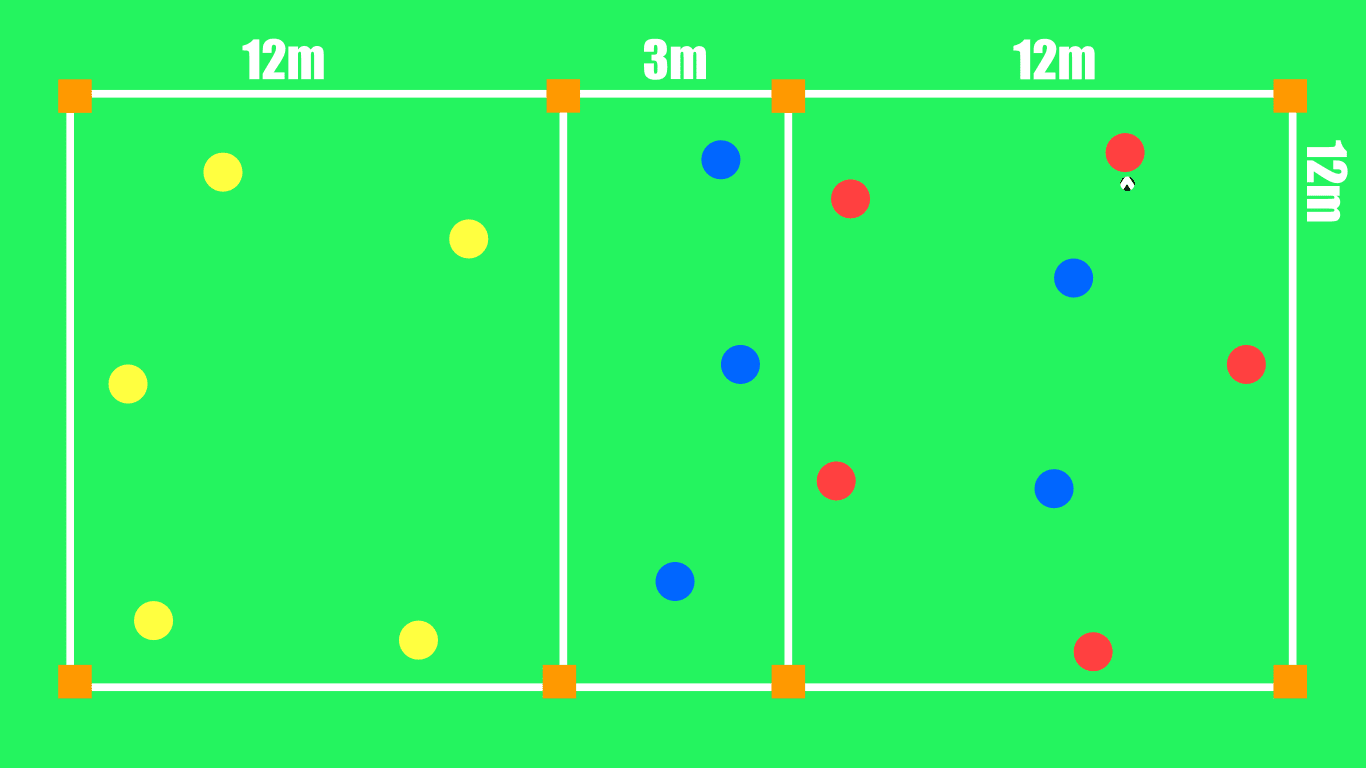
In the image, it is shown how all the teams need to line up at the beginning of the drill. The action starts with Reds passing the ball between themselves trying to get to seven (or less, it depends on your decision of how direct would you like to play it) consecutive passes, after which they can send the ball into the Yellow field, where the Yellows have the same task.
The possessional teams play the passing game in their boxes, with the freedom in motion, as they don’t need to stick next to the sidelines but can play it any way they find fit. The number of touches they have in possession can also vary, but is suggested to encourage your players to play it faster and stick to two-touch football.
When Reds successfully pass the ball into the other area of possession, they stay put in their zone and wait for things to wrap out in the other, where two of the Blues from the neutral zone goes to press and try to win the ball. The two Blue players that have chosen the ball in the first zone run into the neutral area where they protect the width and move in order to close down the potential passing lanes. It is important to point out that no long balls are allowed, which will make it more difficult for players to switch the play.
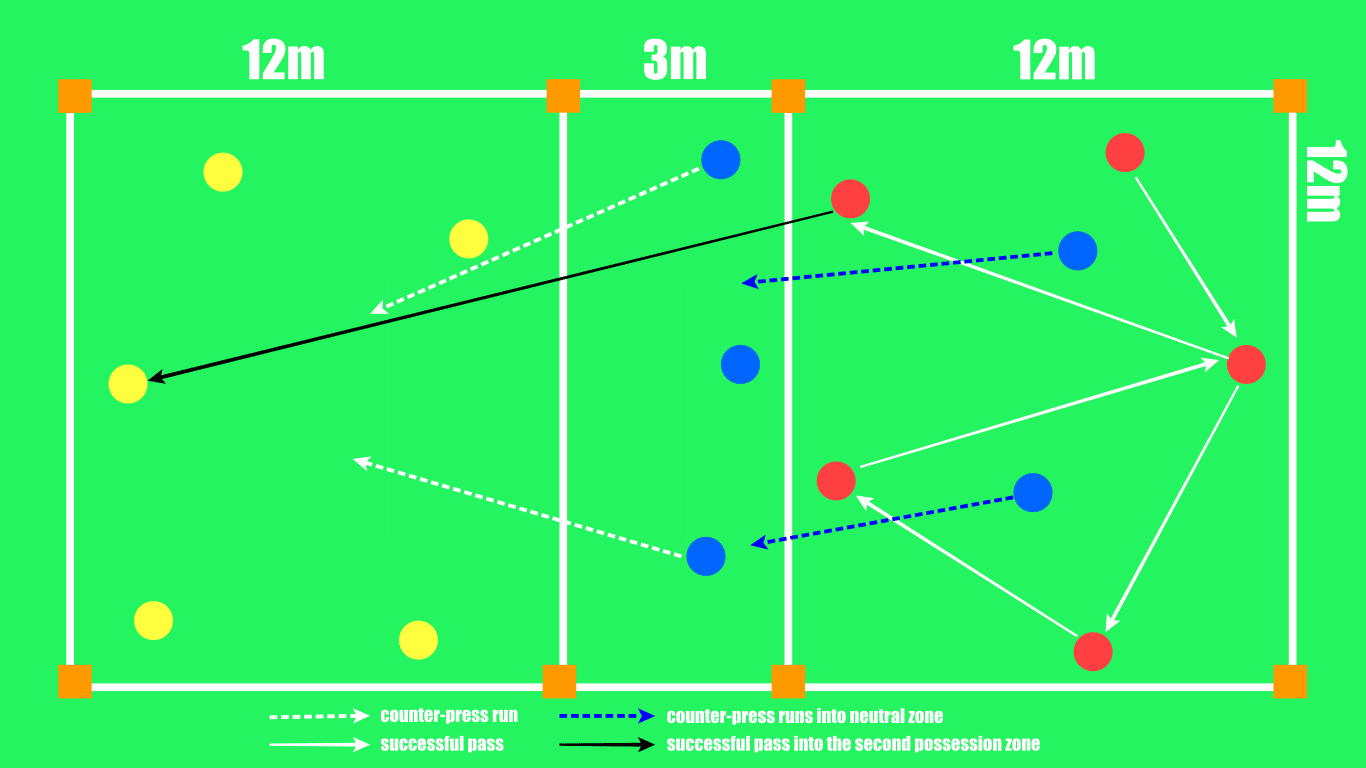
Here you can see the example of successful transition pass after the good passing game from Reds in the first area, and successful transition-pass. Defenders need to communicate between themselves, and to make decisions quickly, mostly in terms of which two will press the opposition after the ball changes feet, and also how will they move in the neutral zone.
That can be seen as the first part of coaching organised pressure, but the thing that helps your players mostly through this drill happens when the possession is lost. When for eg. Reds make an error in their possession field, Blues have the goal to send the ball to the Yellows, which means that Reds are now the defending team, and Blues fill up their spots in the wide-area as the possessional side.
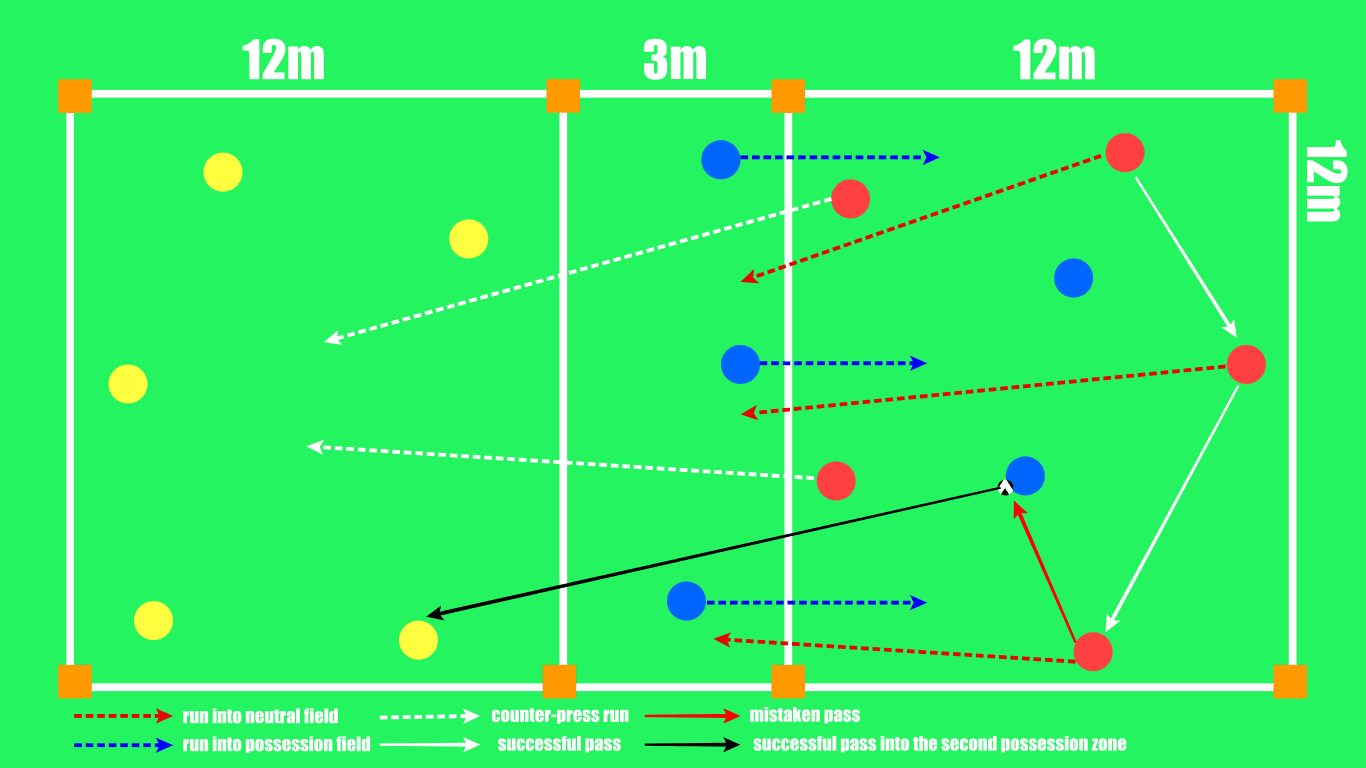
First thing happening after the ball is lost is the counter-pressing coming from the team that was in possession. They need to prevent defenders of switching the play, and if they manage to do it, they remain in their roles with no changes. If Blues somehow find the was to pass the ball into the next field, Reds need to make transitive runs, organising their defence and playing counter-press/press towards the Yellow team.
This game is very useful in coaching many of the game segments, as it unites transition, possessional play, pressing/counter-pressing, communication, defensive organisation, and a lot more of the other skills that are directly involved in the real-time game.
You should encourage your players to be aggressive, but also to be disciplined and to communicate with their teammates while out of possession, which will bring them closer to pressing on a high level in matches. Also, you can make this drill a competitive one by counting the number of defences each team has played or measuring the time teams spent out of possession.
Two-zones counter-pressing and transition
The third drill in this analysis is the one that is played in a slightly bigger field and it is great for the phase of training right before the main one. First of all, it is set in the 25×40 meter pitch, with the half-way line separating the two areas of play. The number of players included in this game is 12 (number can get bigger if you decide so, but then you’ll need to adapt your field), with two teams made of six players.
Initial setup of the drill takes place in one of the two boxes, with six players playing as a possessional team (Reds), and four players chasing for the ball (Blues). Two of the Blue players are positioned in the second zone, waiting for the transitive pass from their teammates after they manage to win the ball.
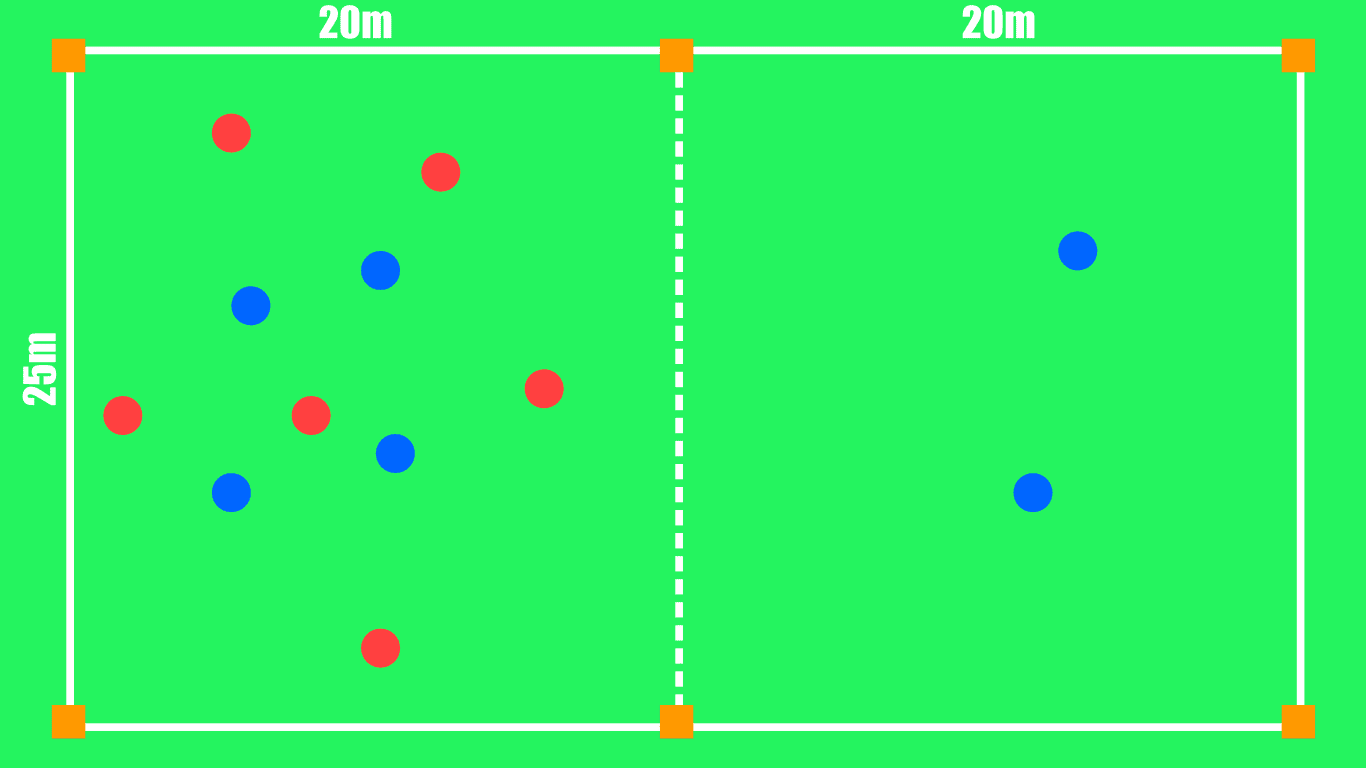
Above we can see the setting of this exercise at first. Red players are allowed to move freely inside the first box, keeping the ball from the Blues. After they succeed in making 10 passes, their team gets a point, and the same goes for Blues if they manage to do it on their half of the pitch. You can also set the point-line lower in order to force defenders press with more will, which will build up their aggression.

Coaches need to induce the defenders to move organised and to keep the structure by communicating between each other, but also to press the opposition in order to win the ball, even though they have numerical inferiority. The key focus for the Blues is finding balance in closing the passing lanes and sensing the right moment to press, which will help your team time their actions better with also creating cohesion when in defence.
When the Reds lose the ball, then it comes to the main part of counter-pressing coaching, as they are asked to press Blues right away and get the ball back in the shortest time possible, trying to utilize on their numerical superiority and the fact Blues are the least prepared for possession at that moment.
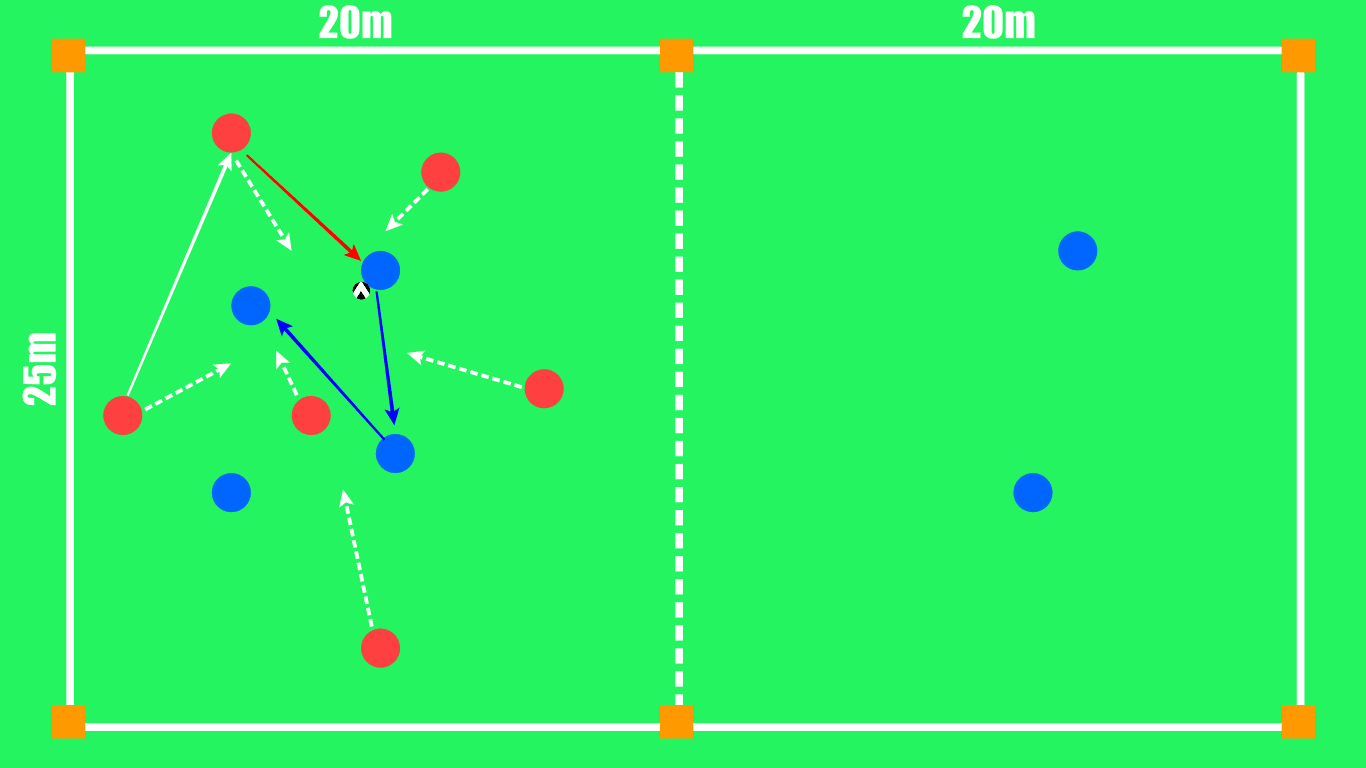
All of the Reds need to counter-press together, closing down the potential pass towards the second area and trying to regain possession. If the Blues manage to find the way to pass the ball towards their half of the pitch, with two players waiting for the ball when the pass is played all of the Blues come back to their half along with four Reds who are now in defensive roles and are trying to do the same thing their opponents did.
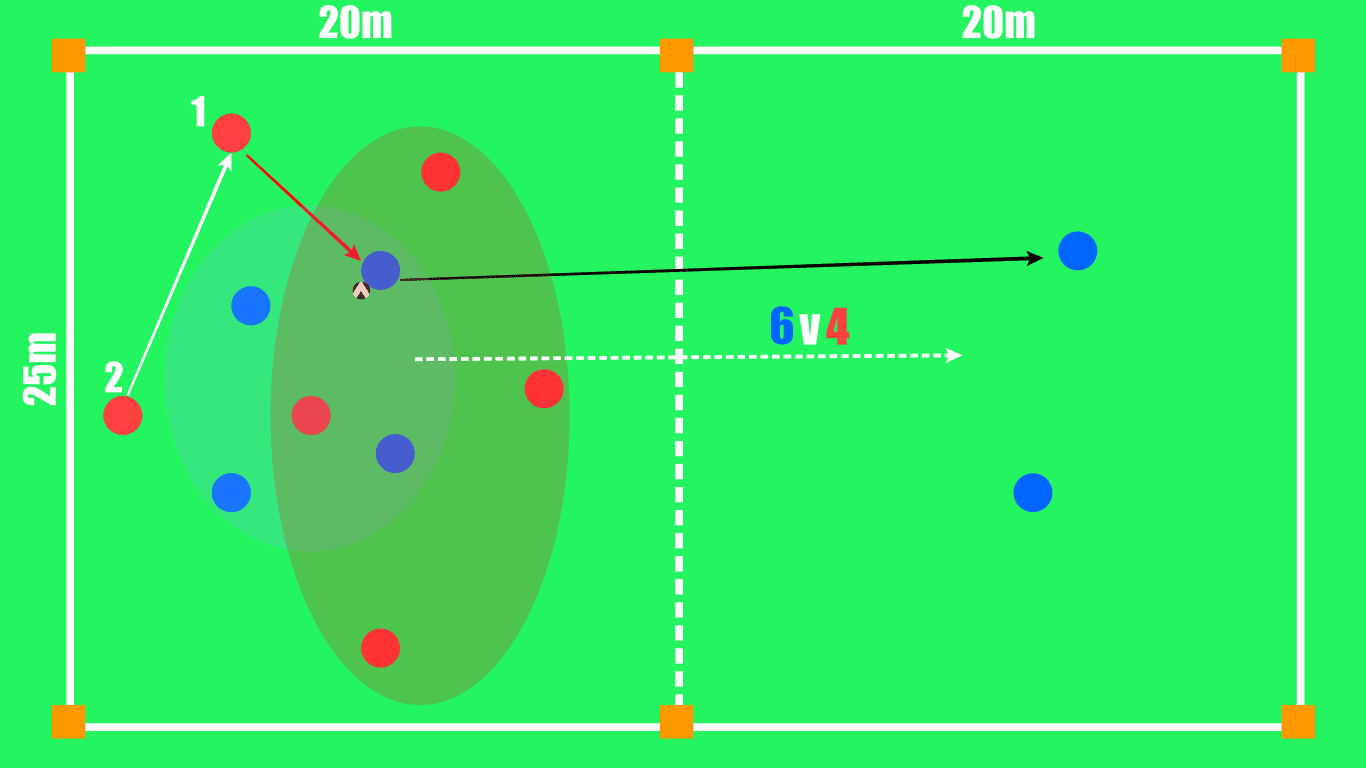
As we can see in the picture above, after the Blue passed the ball to his teammate in the second zone, marked Reds and Blues go together to play 6v4 game on the other half of the pitch. Two Reds remain in their own half, waiting for the transitive pass, as the two Blues did until that moment.
This game is played with a restricted number of touches, the three-touch game is suggested, but you can ask your players to play it with even less if you want them to play more directly. As much as this drill builds your squad’s pressing/counter-pressing game, it also helps in transition coaching, control possession skills, developing understanding and communication between both attackers and defenders, so it is a complete package of exercises that can surely be implemented in the matches.
Conclusion
Pressing and Counter-pressing are nowadays the key factors of the high-tempo game, so it is important for coaches to be familiar with it even if they don’t want to base their out of possession tactics on those two. The drills that we showed to you in this coaching tactical analysis will help you coach your team to play it this way, but also to get better in various of other segments of the game such as defensive organisation, transition and communication.
The keys to good pressing game lay in reactions, so we tried to paint the best exercises you could use to develop your players’ aggression and which ask them to get more engaged when it comes to transitive and counter-pressing situations. It is also recommended to induce your squad to make quicker decisions so their actions would get quicker, which is of great importance when it comes to high-intensity scenarios, which counter-pressing football surely nourishes.





Comments